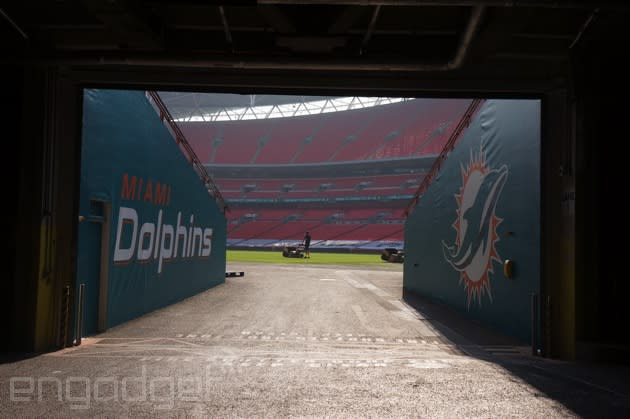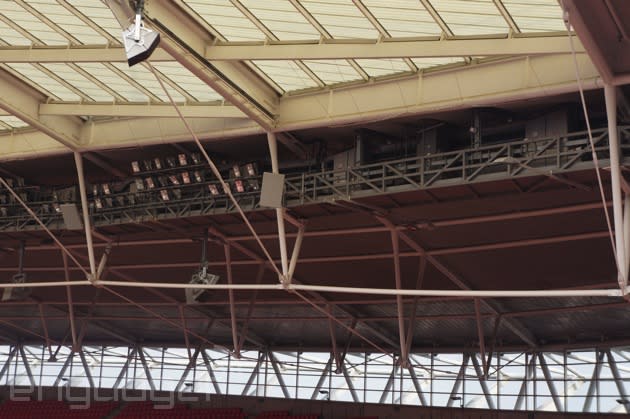Inside Wembley: why it wants to become the world's most connected stadium
With 90,000 seats, Wembley Stadium is the largest stadium in the UK and second biggest in Europe. Demolished in 2003, rebuilt and then re-opened in 2007, the £798 million arena has played home to domestic and European cup finals in various sports, England football qualifiers and numerous open air concerts. Its owners, the Football Association (FA), have strived to "deliver the best experience possible," and for a time, that mainly involved providing hospitality to various types of visitors at the stadium. However, as smartphone use has boomed, visitor needs have changed, and the stadium has been forced to evolve to match their requirements. That isn't to say its owners have resisted change, as we found out when we visited the sporting amphitheatre earlier this week.
Supplying Britain's biggest stadium with 3G and 4G connectivity requires significant investment in infrastructure. Perhaps it should come as no surprise that the UK's largest carrier, EE, is helping it do just that. As part of their six-year partnership announced earlier in the year, the operator has been included in the arena's official name (currently known as Wembley Stadium connected by EE), and you'll see its familiar aqua and yellow branding on nearly every screen and concourse.

When we popped by, Wembley was preparing for the annual return of the NFL. The National Football League, if you didn't know, is a rule unto itself: it comes with a massive entourage of engineers and organisers that have enough clout to force UK regulators to lift restrictions on radio frequencies. Teams need that one specific band to communicate with their quarterbacks after all. With a sellout crowd expected to descend upon the stadium this weekend, EE will get the chance to flex its network muscle, helping Wembley engage with the fans that come through its doors (or should we say turnstiles).
Taking a page from the NFL's biggest teams, Wembley's goal is to become the "best and most connected stadium in the world," says Managing Director Roger Maslin. Unlike Manchester United, which has outlawed the use of tablets and laptops inside Old Trafford, the stadium has embraced mobile, enabling sport lovers and music fans to post tweets, share selfies and ultimately say "I'm here, and you're not."
Hard Data
Of course, being connected is not just about downloading from EE's network. The rise of services like Twitter and Instagram mean it's now just as important to get things up. During just seven major events at Wembley, EE's network handled 1.65TB (terabytes) of downloaded data -- the equivalent to 400,000 "goal downloads." During the same period, over 900GB of data was uploaded, which EE says is equal to 800,000 selfies.
The sheer scale of the stadium and the number of people who turn up to see events means Wembley is the perfect location for EE to perform rigorous trials on its network. That's why it's now become the company's "Mothership," a place where it can deploy and test new technologies before they roll out to the wider public.
"Stadium events are the most difficult things to supply, because everyone wants to do the same thing at the same time, says EE's Development Director Mansoor Hanif. "It's the biggest challenge in the world of networks. Do we build one pipe for just 1 percent of the peak traffic in a week or find intelligent ways to manage it?"

EE has invested in the latter option, choosing to double the transmission capacity of its 3G networks. It's in the unusual position of operating on four 3G frequencies, a result of the merger of Orange and T-Mobile, meaning that Wembley is the only stadium in the world that has a total 20MHz allocation of 3G spectrum. Because it's not just Brits entering the stadium, EE has invested in its WiFi infrastructure too, ensuring visitors can connect in the concourse, bar and press office without having to switch on roaming.
However, as EE is predominantly a 4G-focused operator, there are bigger plans for its LTE networks. Next year, the company will launch its 300Mbps LTE-Advanced network at Wembley, after a successful trial in London's Tech City, putting it on par with Asian carriers and far ahead of its US counterparts. Once that's in place, it will begin trialing speeds of up to 400Mbps, making Wembley the world's fastest stadium with network capacity others can only dream of. The only problem is that there might not be any CAT-9 devices on sale that could actually use it, but the company says it's already speaking to chipset manufacturers to embed it inside future devices.
Contactless Payments
Like Transport for London, Wembley believes in a world of contactless payments and ticketing. All of the stadium's barriers are NFC-enabled, so it's just a simple matter of convincing visitors to use its mobile apps (iOS/Android) instead of paper tickets (when they're updated in the coming weeks). Contactless payments began rolling out in August for the Rugby League Challenge Cup Final, but the stadium's owners don't expect it to be fully available until the fourth quarter, perfect for when the Rugby Union World Cup comes to town in 2015.

"Mobile is about fans engaging and connecting back with us. That's why we're letting people pay with their phones, but also use them to enter the stadium," EE CTO Fotis Karonis told us today. "We welcome two to three million guests every year, but only know a fraction of them. Mobile ticketing means we'll know many more."
If that wasn't enough, Wembley and EE today launched a new lighting system on the stadium's iconic arch. Similar to smart lighting systems like Philips' Hue, the arch has been equipped with the fastest interactive LED lighting system in the world (comprising of 228 LED floodlights that can create millions of colour combinations) to react to goals or crowd noise levels during a concert. Although it was switched on today, Wembley expects the arch to light up properly in early 2015.




















































